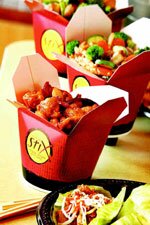|
All Fired Up
Pick Up Stix’s from-scratch redesign draws Pan-Asian inspiration from the wok.
By Lisa Bertagnoli, Contributing Editor
“This is Pick Up Stix?” customers are known to ask, somewhat bewildered, as they enter the chain’s new restaurant in North Corona, Calif.
They can be forgiven for their confusion. More than a mere remodel, Pick Up Stix’s newest store features a new color palette, layout and logo—even the packaging and uniforms are brand new.
Where older restaurants used to crowd order-in and pick-up customers in one space, the new store’s entry segregates patrons into two well-marked lines separated by a 6-foot-tall menu board.
Older stores feature a stark stainless-steel kitchen; this one is filled with crimson counters and sleek cabinets, like a high-style home kitchen. Where the previous design had “aren’t we having fun” photos of guests and employees interacting, the walls of the new look hold arty black-and-white photos of rural China. A palette of reds and golds, instead of bland beiges, wraps the store in a warm, homey feeling.
The change for the 15-year-old, 100-unit concept was long overdue, says Tim Pulido, president and COO of San Clemente, Calif.-based Pick Up Stix, which founder Charles Zhang sold to Carlson Restaurants Worldwide in 2001.
“Pick Up Stix has always been known for great quality, but the restaurant didn’t tell people that,” Pulido says. “It was a quick-casual concept in a fast-food box.”
After joining Pick Up Stix in May of 2003, Pulido immediately began repositioning the brand from Americanized takeout to Pan-Asian dine-in and takeout. Focus groups with customers and even managers from other restaurant chains yielded a new tagline: Fresh Asian Kitchen. The next step was to translate that into the store design.
Pushing the Envelope
Pulido hired Chute Gerdeman, a Columbus, Ohio-based design firm, to rework what he calls the consumer “envelope”: the interior and exterior look, logo, layout, packaging and staff uniforms.
|

| SNAPSHOT |
| Concept |
| Pick Up Stix |
| Location |
| North Corona, Calif. |
| Ownership |
| Carlson Restaurants Worldwide, Dallas |
| Opening Day |
| May 28, 2004 |
| Designer |
| Chute Gerdeman, Columbus, Ohio |
| Area |
| 2,400 square feet |
| Seats |
| 64 |
| Average Check |
| $12.05 |
| Average Unit Volume |
| $1 million |
| Expansion Plans |
| 30 in 2005 |
|
“Tim came to us with the repositioning in hand, and the design followed from there,” says Brian Shafley, president of Chute Gerdeman and the lead designer on the project.
Creating mood boards for “fresh,” “Asian” and “kitchen” led the designers to conceive a look centered around the wok, the literal and figurative symbol for Asian cooking. An eight-burner wok in the open kitchen anchors each Pick Up Stix store, where cooks take great delight in making the flames leap high for guests. The wok image appears in the oversize, jewel-colored “wok lights” suspended over the dining room as well as a display of five woks hanging near the kitchen. Even the new logo, calligraphy-looking letters encased in a jagged-edge circle, conveys a wok-like feeling.
From the mood boards stemmed the color palette of fiery red and gold, found in the design, logo, packaging and uniforms.
To communicate “Asian,” the decor forgoes Chinese elements such as paper lanterns in favor of Pan-Asian details. Bamboo, for instance, is etched in the plastic screens surrounding a semienclosed dining space. Displays of dried chiles, spices and other ingredients decorate the front counter, and a touch of light green in the banquette fabric broadens the predominant red-and-gold palette.
In another Pan-Asian touch, customers now choose sauces from a Flavor Bar that holds six signature sauces plus chow-mein noodles and fortune cookies. The packets of sweet-and-sour, soy and mustard sauces used in the previous incarnation confused customers, created waste and were too Chinese, Pulido says.
As for “kitchen,” the designers’ challenge was to give a homier feeling to the kitchen, formerly an efficient-looking stainless-steel affair. “Asian food is to share in the heart of your home—the kitchen,” Pulido explains. Shafley replaced the utilitarian stainless-steel counters with crimson Corian and installed red laminate drawers with brushed-steel handles for storage.
Traffic Signals
In addition to repositioning the brand, the designers solved a few operational problems. The former layout clumped customers picking up phone orders, who account for 40 percent of sales, with those ordering on-site, a vexing situation for both. “You had people in a hurry standing behind those deciding what to order,” Shafley says.
The new entryway has two lines, each clearly marked “Order Here” and “Pick Up Phone Orders,” separated by a tall menu board. A counter and bench provide seats for phone-order customers; previously, they would occupy a dining-room table.
The expansive entry and three-station ordering counter also relieve the traffic jam of customers watching the wok cooking, Pulido says.
Pulido called on Deterministics, a Kirkland, Wash.-based logistics firm, to put the kitchen at top efficiency. Eliminating steps and streamlining flow trimmed one to three minutes from ticket times for a current average of 10 minutes. The improved layout also boosted the kitchen’s sales volume-per-hour capability by 15 percent to 20 percent.
As a result of the changes, the North Corona store is on track to gross $1 million annually, which is on the high end of the system average of $900,000 to $1 million. Check averages have not increased, but the design is drawing more dine-in customers, Pulido says.
The new store cost about $400,000 to build, a budget-friendly $50,000 above the cost for older stores, Pulido says.
Expansion plans call for 30 restaurants sporting the new look to open this year, all in the chain’s current markets of California, Nevada and Arizona. “We can double in size by remaining in current markets,” Pulido says. In addition, Pick Up Stix is experimenting with a face-lift-like decor package to upgrade the colors and exteriors of existing stores; such a package will probably cost about $15,000, Pulido says.
All in all, the vast changes have resulted in a design that customers like once they recover from their initial shock. Consumer research indicates that 72 percent of customers strongly approve of the new design over the old look, with 16 percent somewhat preferring it and 9 percent stating no preference.
More important, tests of the “Fresh Asian Kitchen” tagline in markets Pick Up Stix does not exist revealed a strong customer affinity. “They get it,” Pulido says.
| MENU SAMPLER |
|
Sharable
 Asian Lettuce Wraps: crisp lettuce leaves served with minced white-meat chicken and assorted fresh vegetables, accompanied by hoisin-fruit sauce, $6.29 Asian Lettuce Wraps: crisp lettuce leaves served with minced white-meat chicken and assorted fresh vegetables, accompanied by hoisin-fruit sauce, $6.29
Stix House Special
Signature dish: caramelized sauce of white wine, garlic and soy finished with green onions and white pepper with choice of chicken, $7.29, or beef, $8.29; add vegetables, $1
Classics from the Asian Kitchen
Lemon Chicken: crispy white-meat chicken wok’d with lemon-ginger sauce and fresh lemon pieces served over crispy rice noodles, $7.29
Lifestyle Choice: Low Fat
Buddha’s Feast: an array of fresh vegetables in choice of dark sauce or white-wine sauce, $6.29
Rice
Steamed White or Brown Rice, $1.79 large, $1.29 small
|
|
|

